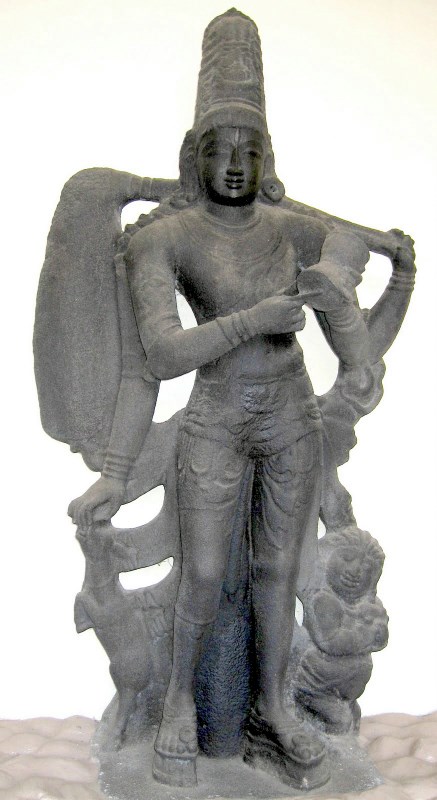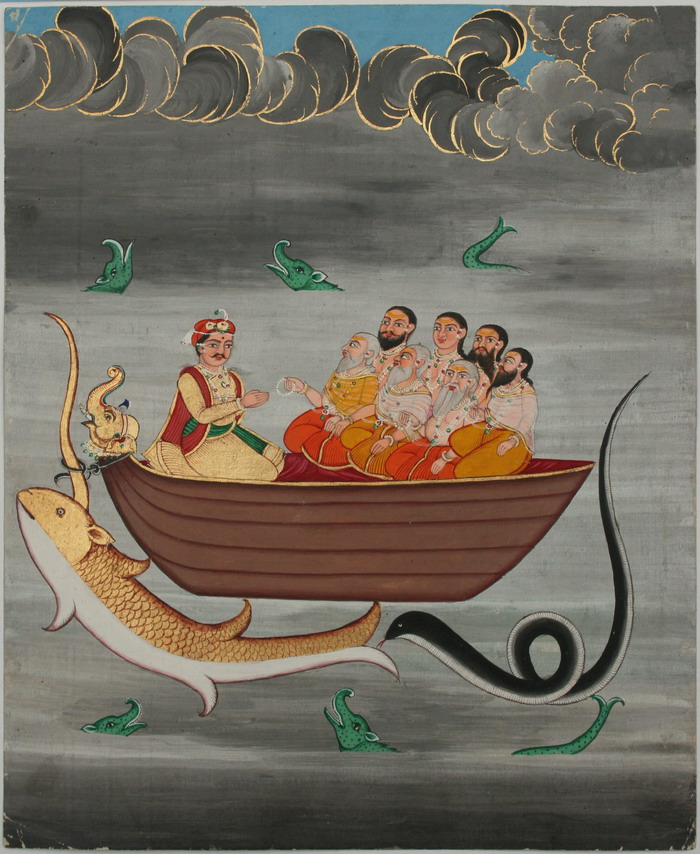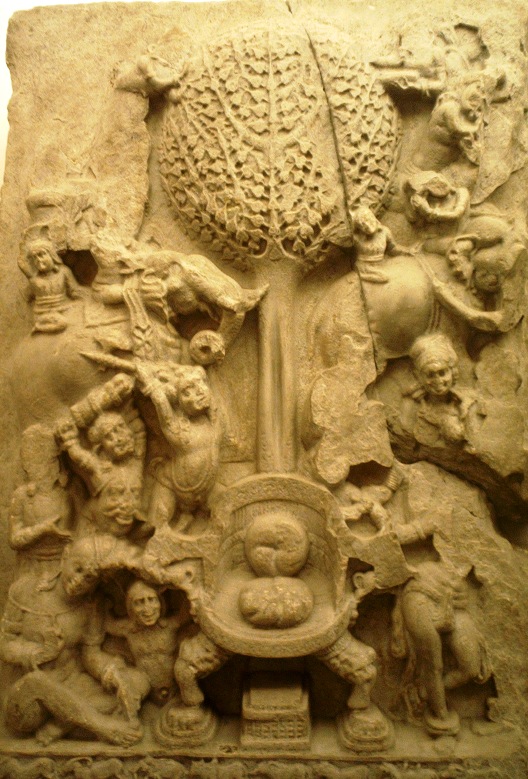|
Bhikshatana
Bhikshatana ( sa, भिक्षाटन; ; literally, "wandering about for alms, mendicancy") or Bhikshatana-murti () is an aspect of the Hindu god Shiva as the "Supreme mendicant" or the "Supreme Beggar". Bhikshtana is depicted as a nude four-armed man adorned with ornaments who holds a begging bowl in his hand and is followed by demonic attendants. Bhikshatana is considered a gentler form of Shiva's fierce aspect Bhairava and a gentle phase between Bhairava's two gruesome forms, one of which decapitates one head of the four headed god Brahma and the other of which kills the god Vishnu's gatekeeper. Bhikshatana is the form of Bhairava that Shiva assumes to atone for his sin of severing Brahma's fifth head. He wanders the universe in the form of a naked Kapali mendicant, begging for alms with Brahma's kapala (skullcup) as his begging bowl, until his sin is expiated upon reaching the holy city of Varanasi. Another legend describes Bhikshtana's visit to the Deodar (Pine) Fo ... [...More Info...] [...Related Items...] OR: [Wikipedia] [Google] [Baidu] |
Kankalamurti
Kankala-murti ("One with the skeleton"), also known as Kankala ("skeleton") or Kankala-Bhairava, is an iconographical form of the Hindu god Shiva. He is often associated with a fearsome aspect of Shiva, Bhairava and thus considered the latter's aspect too. Kankalamurti is popular in South Indian temples of Shiva, but almost unknown in North India. He is described in legends to have defeated and slain Vishnu's army-chief and gate-keeper Vishvaksena or Vishnu's avatar Vamana. He is depicted as a four-armed man with a ''kankala-danda'' (skeleton-staff) in his hand and followed by demonic attendants and love-sick women. Legend Kankalamurti is one of the three most popular aspects of Bhairava; the others being Brahmashiraschedaka-murti and Bhikshatana-murti. Shiva – as the terrifying Bhairava – cuts the fifth head of the creator-god Brahma (an act iconographically depicted as Brahmashiraschedaka-murti) and that head/skull stuck as kapala (skull-cup) to Bhairava's left palm due to ... [...More Info...] [...Related Items...] OR: [Wikipedia] [Google] [Baidu] |
Shiva
Shiva (; sa, शिव, lit=The Auspicious One, Śiva ), also known as Mahadeva (; ɐɦaːd̪eːʋɐ, or Hara, is one of the principal deities of Hinduism. He is the Supreme Being in Shaivism, one of the major traditions within Hinduism. Shiva is known as "The Destroyer" within the Trimurti, the Hindu trinity which also includes Brahma and Vishnu. In the Shaivite tradition, Shiva is the Supreme Lord who creates, protects and transforms the universe. In the goddess-oriented Shakta tradition, the Supreme Goddess ( Devi) is regarded as the energy and creative power (Shakti) and the equal complementary partner of Shiva. Shiva is one of the five equivalent deities in Panchayatana puja of the Smarta tradition of Hinduism. Shiva has many aspects, benevolent as well as fearsome. In benevolent aspects, he is depicted as an omniscient Yogi who lives an ascetic life on Mount Kailash as well as a householder with his wife Parvati and his three children, Ganesha, Kartikeya and A ... [...More Info...] [...Related Items...] OR: [Wikipedia] [Google] [Baidu] |
Mohini
Mohini (Sanskrit: मोहिनी, ') is the Hindu goddess of enchantment. She is the only female avatar of the Hindu god Vishnu. She is portrayed as a ''femme fatale'', an enchantress, who maddens lovers and demons, sometimes leading them to their doom. Mohini is introduced into Hinduism in the narrative epic of the ''Mahabharata''. Here, she appears as a form of Vishnu following the Churning of the Ocean, a mesmerising beauty who distributes the amrita (the elixir of immortality) to the weakened devas (gods) and depriving it to the dominant asuras (demons), allowing the former to defeat the latter with their newfound immortality. Many different legends tell of her various exploits and marriages, including her union with the god Shiva. These tales relate, among other things, the birth of the god Shasta and the destruction of Bhasmasura, the ash-demon. Mohini's main ''modus operandi'' is to trick or beguile those she encounters. She is worshipped throughout Indian culture, ... [...More Info...] [...Related Items...] OR: [Wikipedia] [Google] [Baidu] |
Annamalaiyar Temple
Arunachalesvara Temple (also called Annamalaiyar Temple) is a Hindu temple dedicated to the deity Shiva, located at the base of Arunachala hill in the town of Thiruvannamalai in Tamil Nadu, India. It is significant to the Hindu sect of Shaivism as one of the temples associated with the five elements, the '' Pancha Bhoota Stalas'', and specifically the element of fire, or Agni. Shiva is worshiped as Arunachalesvara or Annamalaiyar, and is represented by the ''lingam'', with his idol referred to as ''Agni lingam''. His consort Parvati is depicted as Unnamalai Amman or Apithakucha Ambal. The presiding deity is revered in the 7th-century Tamil Saiva canonical work, the ''Tevaram'', written by Tamil saint poets known as the nayanars and classified as ''Paadal Petra Sthalam''. The 9th-century ''Saiva'' saint poet Manikkavasagar composed the ''Tiruvempaavai'' here. The temple complex covers 10 hectares, and is one of the largest in India. It houses four gateway towers known as ''go ... [...More Info...] [...Related Items...] OR: [Wikipedia] [Google] [Baidu] |
South India
South India, also known as Dakshina Bharata or Peninsular India, consists of the peninsular southern part of India. It encompasses the Indian states of Andhra Pradesh, Karnataka, Kerala, Tamil Nadu, and Telangana, as well as the union territories of Lakshadweep and Puducherry, comprising 19.31% of India's area () and 20% of India's population. Covering the southern part of the peninsular Deccan Plateau, South India is bounded by the Bay of Bengal in the east, the Arabian Sea in the west and the Indian Ocean in the south. The geography of the region is diverse with two mountain ranges – the Western and Eastern Ghats – bordering the plateau heartland. The Godavari, Krishna, Kaveri, Tungabhadra, Periyar, Bharathappuzha, Pamba, Thamirabarani, Palar, and Vaigai rivers are important perennial rivers. The majority of the people in South India speak at least one of the four major Dravidian languages: Tamil, Telugu, Malayalam and Kannada (all 4 of which are among the 6 Classic ... [...More Info...] [...Related Items...] OR: [Wikipedia] [Google] [Baidu] |
North India
North India is a loosely defined region consisting of the northern part of India. The dominant geographical features of North India are the Indo-Gangetic Plain and the Himalayas, which demarcate the region from the Tibetan Plateau and Central Asia. The term North India has varying definitions. The Ministry of Home Affairs in its Northern Zonal Council Administrative division included the states of Haryana, Himachal Pradesh, Punjab and Rajasthan and Union Territories of Chandigarh, Delhi, Jammu and Kashmir and Ladakh. The Ministry of Culture in its ''North Culture Zone'' includes the state of Uttarakhand but excludes Delhi whereas the Geological Survey of India includes Uttar Pradesh and Delhi but excludes Rajasthan and Chandigarh. Other states sometimes included are Bihar, Gujarat, Jharkhand, Madhya Pradesh and West Bengal. North India has been the historical centre of the Mughal Empire, the Delhi Sultanate and the British Indian Empire. It has a diverse culture, and includ ... [...More Info...] [...Related Items...] OR: [Wikipedia] [Google] [Baidu] |
Tamil Nadu
Tamil Nadu (; , TN) is a States and union territories of India, state in southern India. It is the List of states and union territories of India by area, tenth largest Indian state by area and the List of states and union territories of India by population, sixth largest by population. Its capital and largest city is Chennai. Tamil Nadu is the home of the Tamil people, whose Tamil language—one of the longest surviving Classical languages of India, classical languages in the world—is widely spoken in the state and serves as its official language. The state lies in the southernmost part of the Indian peninsula, and is bordered by the Indian union territory of Puducherry (union territory), Puducherry and the states of Kerala, Karnataka, and Andhra Pradesh, as well as an international maritime border with Sri Lanka. It is bounded by the Western Ghats in the west, the Eastern Ghats in the north, the Bay of Bengal in the east, the Gulf of Mannar and Palk Strait to the south-eas ... [...More Info...] [...Related Items...] OR: [Wikipedia] [Google] [Baidu] |
Tamil Language
Tamil (; ' , ) is a Dravidian language natively spoken by the Tamil people of South Asia. Tamil is an official language of the Indian state of Tamil Nadu, the sovereign nations of Sri Lanka and Singapore, and the Indian territory of Puducherry. Tamil is also spoken by significant minorities in the four other South Indian states of Kerala, Karnataka, Andhra Pradesh and Telangana, and the Union Territory of the Andaman and Nicobar Islands. It is also spoken by the Tamil diaspora found in many countries, including Malaysia, Myanmar, South Africa, United Kingdom, United States, Canada, Australia and Mauritius. Tamil is also natively spoken by Sri Lankan Moors. One of 22 scheduled languages in the Constitution of India, Tamil was the first to be classified as a classical language of India. Tamil is one of the longest-surviving classical languages of India.. "Tamil is one of the two longest-surviving classical languages in India" (p. 7). A. K. Ramanujan described it as "the on ... [...More Info...] [...Related Items...] OR: [Wikipedia] [Google] [Baidu] |
Rishi
''Rishi'' () is a term for an accomplished and enlightened person. They find mentions in various Vedic texts. Rishis are believed to have composed hymns of the Vedas. The Post-Vedic tradition of Hinduism regards the rishis as "great yogis" or "sages" who after intense meditation (tapas) realized the supreme truth and eternal knowledge, which they composed into hymns.Hartmut Scharfe (2002), Handbook of Oriental Studies, BRILL Academic, , pp. 13–15. The term appears in Pali literature as Ishi and in Buddhism, they can be either Buddhas, Paccekabuddhas, Arahats or a monk of high rank. Etymology According to Indian tradition, the word may be derived from two different meanings of the root 'rsh' (). Sanskrit grammarians derive this word from the second meaning: "to go, to move". V. S. Apte gives this particular meaning and derivation, and Monier-Williams also gives the same, with some qualification. Another form of this root means "to flow, to move near by flowing". (All the ... [...More Info...] [...Related Items...] OR: [Wikipedia] [Google] [Baidu] |
Kurma Purana
The ''Kurma Purana'' (IAST: Kūrma Purāṇa) is one of the eighteen Mahapuranas, and a medieval era Vaishnavism text of Hinduism. The text is named after the tortoise avatar of Vishnu. The manuscripts of ''Kurma Purana'' have survived into the modern era in many versions. The number of chapters vary with regional manuscripts, and the critical edition (edited by Anand Swarup Gupta, and published by the All-India Kashiraj Trust, Varanasi) of the ''Kurma Purana'' has 95 chapters. Tradition believes that the ''Kurma Purana'' text had 17,000 verses, the extant manuscripts have about 6,000 verses. The text, states Ludo Rocher, is the most interesting of all the Puranas in its discussion of religious ideas, because while it is a Vaishnavism text, Vishnu does not dominate the text. Instead, the text covers and expresses reverence for Vishnu, Shiva and Shakti with equal enthusiasm. The ''Kurma Purana'', like other Puranas, includes legends, mythology, geography, ''Tirtha'' (pilgrimage ... [...More Info...] [...Related Items...] OR: [Wikipedia] [Google] [Baidu] |
Aniconic
Aniconism is the absence of artistic representations (''icons'') of the natural and supernatural worlds, or it is the absence of representations of certain figures in religions. It is a feature of various cultures, particularly of cultures which are based on monotheistic Abrahamic religions. The prohibition of material representations may only extend from God and other supernatural beings to saint-like characters, or it may extend to material representations of all living beings, and material representations of everything that exists. The phenomenon is generally codified by religious traditions and as such, it becomes a taboo. When it is enforced by the physical destruction of images, aniconism becomes iconoclasm. Aniconism has been a historical phase in both Buddhism and Christianity, and even though it is much less of an issue today, the attitudes towards religious imagery show considerable variability between different traditions, denominations, and strands within each religio ... [...More Info...] [...Related Items...] OR: [Wikipedia] [Google] [Baidu] |









